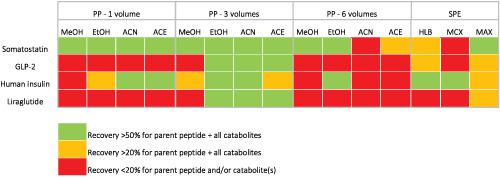当前位置:
X-MOL 学术
›
J. Pept. Sci.
›
论文详情
Our official English website, www.x-mol.net, welcomes your
feedback! (Note: you will need to create a separate account there.)
Comparison of different protein precipitation and solid-phase extraction protocols for the study of the catabolism of peptide drugs by LC-HRMS.
Journal of Peptide Science ( IF 1.8 ) Pub Date : 2020-07-06 , DOI: 10.1002/psc.3272 Simone Esposito 1 , Domitilla Vanni 2 , Sergio Menta 1 , Laura Orsatti 1 , Edith Monteagudo 1
Journal of Peptide Science ( IF 1.8 ) Pub Date : 2020-07-06 , DOI: 10.1002/psc.3272 Simone Esposito 1 , Domitilla Vanni 2 , Sergio Menta 1 , Laura Orsatti 1 , Edith Monteagudo 1
Affiliation

|
LC‐HRMS‐based identification of the products of peptide catabolism is the key to drive the design of more stable compounds. Because the catabolite of a given peptide can be very different from the parent compound and from other catabolites in terms of physicochemical properties, it can be challenging to develop an analytical method that allows recovery and detection of the parent and all parent‐related catabolites. The aim of this study was to investigate how the recovery and the matrix effect of peptidic drugs and their catabolites are affected by different protein precipitation (PP) and solid‐phase extraction (SPE) protocols. To this purpose, four model peptides representative of different classes (somatostatin, GLP‐2, human insulin and liraglutide) were digested with trypsin and chymotrypsin to simulate proteolytic catabolism. The resulting mixtures of the parent peptides and their proteolytic products covering a wide range of relative hydrophobicity (HR) and isoelectric points (pI) were spiked in human plasma and underwent different PP and SPE protocols. Recovery and matrix effect were measured for each peptide and its catabolites. PP with three volumes of ACN or EtOH yielded the highest overall recoveries (more than 50% for the four parent peptides and all their catabolites) among all the tested PP and SPE protocols. Mixed‐mode anion exchange (MAX) was the only SPE sorbent among the five tested that allowed to extract all the peptides with recoveries more than 20%. Matrix effect was generally lower with SPE. Overall, it was observed that peptides with either high hydrophilicity (e.g., somatostatin catabolites) or hydrophobicity (GLP‐2 and lipidated liraglutide catabolites) had a much narrower choice of PP solvent or SPE protocol. Simulation of catabolism using recombinant enzymes together with in silico calculation of the HR and the pI of potential proteolysis products is recommended to select the optimal extraction conditions for the study of peptide catabolism.
中文翻译:

LC-HRMS用于研究肽类药物分解代谢的不同蛋白质沉淀和固相萃取方案的比较。
基于LC-HRMS的肽分解代谢产物的鉴定是推动设计更稳定化合物的关键。由于给定肽的分解代谢物在理化性质方面可能与母体化合物和其他分解代谢物有很大差异,因此开发一种可以回收和检测母体和所有与母体相关的分解代谢物的分析方法可能具有挑战性。这项研究的目的是研究肽类药物及其分解代谢产物的回收率和基质效应如何受到不同的蛋白质沉淀(PP)和固相萃取(SPE)方案的影响。为此,用胰蛋白酶和胰凝乳蛋白酶消化代表不同类别(生长抑素,GLP-2,人胰岛素和利拉鲁肽)的四种模型肽,以模拟蛋白水解分解代谢。^ h [R)和等电点(pI)掺入人血浆中并接受不同的PP和SPE规程。测量每种肽及其分解代谢物的回收率和基质效应。在所有测试的PP和SPE方案中,具有三倍体积的ACN或EtOH的PP的总体回收率最高(四种亲本肽及其所有分解代谢物的回收率均超过50%)。混合模式阴离子交换(MAX)是五种被测试的SPE吸附剂中唯一的一种,它可以提取所有回收率超过20%的肽。SPE的基质效应通常较低。总体而言,观察到具有高亲水性(例如生长抑素分解代谢物)或疏水性(GLP-2和脂化的利拉鲁肽分解代谢物)的肽在PP溶剂或SPE方案中的选择范围要窄得多。建议使用H R和潜在的蛋白水解产物的pI为研究肽分解代谢选择最佳的提取条件。
更新日期:2020-07-06
中文翻译:

LC-HRMS用于研究肽类药物分解代谢的不同蛋白质沉淀和固相萃取方案的比较。
基于LC-HRMS的肽分解代谢产物的鉴定是推动设计更稳定化合物的关键。由于给定肽的分解代谢物在理化性质方面可能与母体化合物和其他分解代谢物有很大差异,因此开发一种可以回收和检测母体和所有与母体相关的分解代谢物的分析方法可能具有挑战性。这项研究的目的是研究肽类药物及其分解代谢产物的回收率和基质效应如何受到不同的蛋白质沉淀(PP)和固相萃取(SPE)方案的影响。为此,用胰蛋白酶和胰凝乳蛋白酶消化代表不同类别(生长抑素,GLP-2,人胰岛素和利拉鲁肽)的四种模型肽,以模拟蛋白水解分解代谢。^ h [R)和等电点(pI)掺入人血浆中并接受不同的PP和SPE规程。测量每种肽及其分解代谢物的回收率和基质效应。在所有测试的PP和SPE方案中,具有三倍体积的ACN或EtOH的PP的总体回收率最高(四种亲本肽及其所有分解代谢物的回收率均超过50%)。混合模式阴离子交换(MAX)是五种被测试的SPE吸附剂中唯一的一种,它可以提取所有回收率超过20%的肽。SPE的基质效应通常较低。总体而言,观察到具有高亲水性(例如生长抑素分解代谢物)或疏水性(GLP-2和脂化的利拉鲁肽分解代谢物)的肽在PP溶剂或SPE方案中的选择范围要窄得多。建议使用H R和潜在的蛋白水解产物的pI为研究肽分解代谢选择最佳的提取条件。











































 京公网安备 11010802027423号
京公网安备 11010802027423号